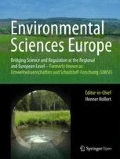Zusammenfassung
Ziel und Hintergrund
Hochofengasschlamm ist ein Abfallprodukt der Roheisenerzeugung, das Schadstoffe wie Blei, Zink, Fluorid und Cyanid enthält und über Auswaschung das Grundwasser belasten kann.
Methoden
Wir untersuchten die chemische Zusammensetzung von 27 Proben deponierter Hochofengasschlämme in Porenwässern, die durch Zentrifugieren feldfrischen Materials gewonnen wurden und in Eluaten nach DIN 38414 Teil 4 (S 4).
Ergebnisse
Sowohl die Porenwässer als auch die Eluate waren neutral bis alkalisch (pH 7,3 bis 10,7) und wurden von Alkali-und Erdalkalimetallen sowie Sulfat und Nitrat dominiert. Die Konzentrationen sämtlicher untersuchten Elemente und Verbindungen waren in den Porenwässern meist deutlich höher als in den Eluaten. Die durchschnittlichen Konzentrationen in den Porenwässern der umweltrelevanten Bestandteile Blei (0,18 mgl−1), Zink (1,5 mgl−1), Fluorid (10,6 mgl−1) und Gesamtcyanid (1,8 mgl−1) lagen deutlich über den Prüfwerten der Bundes-Bodenschutz-und Altlastenverordnung für den Wirkungspfad Boden-Grundwasser. Blei-, Zink- und Gesamtcyanidkonzentrationen in den Porenwässern wurden in Eluaten sehr stark unterschätzt, da diese Konzentrationen in den Eluaten um 70 bis 90% geringer als in den Porenwässern waren.
Schlussfolgerung
Im Fall deponierter Hochofengasschlämme liefern Eluate nach DIN 38414 Teil 4 (S 4) unrealistisch geringe Stoffkonzentrationen zur Sickerwasserprognose.
Abstract
Goal and Scope
Blast-furnace sludge is a waste originating from pig-iron production and contains contaminants such as lead, zinc, fluoride and cyanide assumably contaminating the groundwater by leaching.
Methods
We investigated the chemical composition of 27 samples of landfilled blast-furnace sludge in pore waters which were obtained by the centrifugation of fresh material and elution with water according to DIN 38414 part 4 (S 4).
Results
The pore waters as well as the eluates were neutral to alkaline (pH 7.3 to 10.7) and were dominated by alkali and alkaline-earth metals as well as sulphate and nitrate. The concentrations of all elements and compounds investigated were mostly clearly larger in the pore waters than in the eluates. The average concentrations of environmentally relevant constituents such as lead (0,18 mg−1), zinc (1,5 mg l−1), fluoride (10,6 mg l−1), and total cyanide (1.8 mg l−1) in the pore waters were distinctly larger than the inspection value of the German Federal soil Protection Ordinance for the pathway soil-groundwater. Lead, zinc, and total cyanide concentrations in the pore waters were largely underestimated by the eluates, as these concentrations were 70 to 90% lower in the eluates compared to the pore waters.
Conclusion
In the case of landfilled blast-furnace sludge, eluates according to DIN 38414 part 4 (S 4) provide low concentrations which are unrealistic to forecast concentrations in the seepage water.
Literatur
BBodSchV (1999): Verordnung zu Durchführung des Bundes-Bodenschutzgesetzes (Bundes-Bodenschutz- und Altlastenverordnung BBodSchV) vom 16.7.1999, BGBl., I, 1554–1582
DIN 19730 (1997): Bodenbeschaffenheit — Extraktion von Spurenelementen mit Ammoniumnitratlösung. VCH, Weinheim
DIN 38414 (1984): DEV Deutsche Einheitsverfanren zur Wasser-, Abwasser- und Schlammuntersuchung, Schlamm und Sedimente (Gruppe S). Bestimmung der Eluierbarkeit mit Wasser (S 4), Teil 14, VCH, Weinheim
Lopez-Delgado A, Perez C, Lopez FA (1998): Sorption of heavy metals on blast furnace sludge. Water Res 32, 989–996
Mansfeldt T (2003): Mobilität und Mobilisierbarkeit von eisenkomplexierten Cyaniden — Untersuchungen in Kokereiböden und Gichtgasschlämmen. Materialien zur Altlastensanierung und zum Bodenschutz 16. Landesumweltamt Nordrhein-Westfalen, Essen. «http://www.lua.nrw.de»
Mansfeldt T, Biernath H (2001): Method comparison for the determination of total cyanide in deposited blast furnace sludge. Anal Chim Acta 435, 377–384
Mansfeldt T, Dohrmann R (2001): Identification of a crystalline cyanide-containing compound in blast furnace sludge deposits. J Environ Qual 30, 1927–1932
Rennert T, Mansfeldt T (2002): Sorption and desorption of ironcyanide complexes in deposited blast furnace sludge. Water Res 36, 4877–4883
Rennert T, Mansfeldt T (2004): Cyanide extraction from contaminated soil: A method comparison. Europ J Mineral Process Environ Protection, im Druck
Scheffer F, Schachtschabel P (2002): Lehrbuch der Bodenkunde. 15. Auflage, Spektrum Akademischer Verlag, Heidelberg
Utermann J, Gäbler H-E, Hindel R, Kues J, Mederer J, Pluquet E (1998): Schwermetallgehalte im Bodenwasser — ein Vergleich von drei Extraktionsverfahren. Z Angew Geol 44, 204–209
van Herck P, Vandecasteele C, Swennen R, Mortier R (2000): Zinc and lead removal from blast furnace sludge with a hydrometallurgical process. Environ Sci Technol 34, 3802–3808
Author information
Authors and Affiliations
Corresponding author
Additional information
Online First: 09. Februar 2004
Rights and permissions
About this article
Cite this article
Rennert, T., Mansfeldt, T. Bewertung der potenziellen Grundwasserbelastung von deponierten Hochofengasschlämmen. UWSF - Z Umweltchem Ökotox 16, 151–154 (2004). https://doi.org/10.1065/uwsf2004.02.075
Received:
Accepted:
Issue Date:
DOI: https://doi.org/10.1065/uwsf2004.02.075

